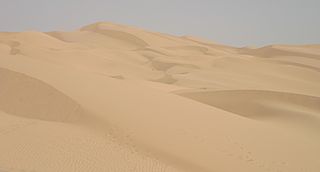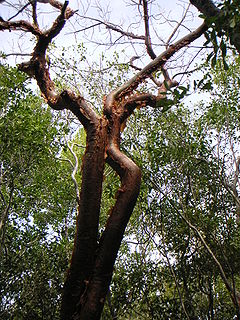The panacea, named after the Greek goddess of universal remedy Panacea, is any supposed remedy that is claimed to cure all diseases and prolong life indefinitely. It was in the past sought by alchemists in connection with the elixir of life and the philosopher's stone, a mythical substance which would enable the transmutation of common metals into gold.

The South Mountains, known locally as simply South Mountain, is a mountain range in central Arizona in south Phoenix, Arizona. It is on public land managed by the city of Phoenix as South Mountain Park.

San Ignacio is a palm oasis town in Mulegé Municipality of northern Baja California Sur state in Mexico.

The Yuma Desert is a lower-elevation section of the Sonoran Desert in the southwestern United States and the northwest of Mexico. It lies in the Salton basin. The desert contains areas of sparse vegetation and has notable areas of sand dunes. With an average rainfall less than 8 inches (200 mm) each year, this is among the harshest deserts in North America. Human presence is sparse throughout, the largest city being Yuma, Arizona, on the Colorado River and the border of California.

The Burseraceae are a moderate-sized family of 17-19 genera and about 540 species of flowering plants. The actual numbers differ according to the time period in which a given source is written describing this family. The Burseraceae are also known as the torchwood family, the frankincense and myrrh family, or simply the incense tree family. The family includes both trees and shrubs, and is native to tropical regions of Africa, Asia, and the Americas.

Bursera graveolens, known in Spanish as palo santo, is a wild tree native from the Yucatán Peninsula to Peru and Venezuela.

Bursera simaruba, commonly known as gumbo-limbo, copperwood, chaca, and turpentine tree, is a tree species in the family Burseraceae, native to tropical regions of the Americas from South Florida to Mexico and the Caribbean to Brazil, Jinotega and Venezuela. Bursera simaruba are prevalent in the Petenes mangroves ecoregion of the Yucatán, where it is a subdominant plant species to mangroves.

Bursera, named after the Danish botanist Joachim Burser (1583-1639), is a genus with about 100 described species of flowering shrubs and trees varying in size up to 25 m (82 ft) high. It is the type genus for Burseraceae. The trees are native to the Americas, from the southern United States south through to northern Argentina, in tropical and warm temperate forest habitats.

Bursera microphylla is a North American species of tree in the frankincense family in the soapwood order. Bursera microphylla, known by the common name elephant tree in English or 'torote' in Spanish, is a tree in genus Bursera. It grows into a distinctive sculptural form, with a thickened, water-storing or caudiciform trunk. It is found in the southwestern United States and northwestern Mexico.

The Pinacate Peaks are a group of volcanic peaks and cinder cones located mostly in the Mexican state of Sonora along the international border adjacent to the U.S. state of Arizona, surrounded by the vast sand dune field of the Gran Desierto de Altar, at the desert's southeast.
Bursera glabrifolia is a Mexican species of trees native to central Mexico.
The Tule Mountains is a mountain range in Yuma County, Arizona. There is a diverse flora and fauna population within the Tule Mountains; one of the notable trees found in this mountain range is the elephant tree.
The Sierra de San Francisco is a mountain range in Mulegé Municipality of the northern region of Baja California Sur state, in northwestern Mexico.

Bursera fagaroides is a species of flowering plant in the genus Bursera known by the common names torchwood copal and fragrant bursera. It is widespread across much of Mexico from Sonora to Oaxaca, and its range extends just into Arizona in the United States, although some sources suggest that it may now be extirpated in Arizona.

The Waterman Mountains are a low mountainous landform in Pima County, United States. Notable among the tree species is the elephant tree which species exhibits a contorted multi-furcate architecture; most of these froze in the cold winter of 2011. The Waterman Mountain range is in the Ironwood Forest National Monument.
Bursera bipinnata is a Mesoamerican species of trees widespread across Mexico and Central America from Chihuahua to Honduras.
Bursera cerasifolia is an uncommon North American species of trees in the Frankincense Family in the soapwood order. It has been found only in the State of Baja California Sur in northwestern Mexico.
Bursera filicifolia is an uncommon North American species of trees in the Frankincense Family in the soapwood order. It has been found only in the States of Sonora and Baja California Sur in northwestern Mexico.
Bursera laxiflora is a North American species of trees in the frankincense family in the soapwood order, native to northwestern Mexico. It is fairly common in Sonora with additional populations in Sinaloa, Baja California Sur, and Socorro Island. There is a report of the species being found in the United States, but it is from the property of the Arizona-Sonora Desert Museum west of Tucson, most likely a cultivated or escaped specimen.

The Southern Pacific dry forests is a tropical dry broadleaf forest ecoregion in southern Mexico.











